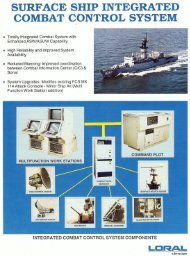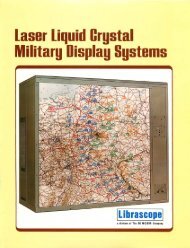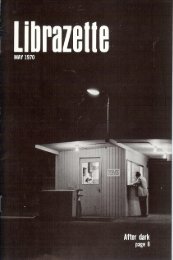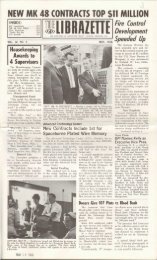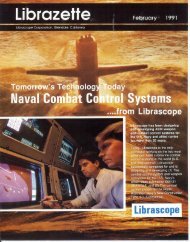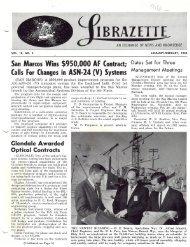Technical Review - Fall 1959. - Librascope Memories
Technical Review - Fall 1959. - Librascope Memories
Technical Review - Fall 1959. - Librascope Memories
You also want an ePaper? Increase the reach of your titles
YUMPU automatically turns print PDFs into web optimized ePapers that Google loves.
Colorado utility uses LIBRATROL-500 for increased efficiency and profits<br />
1Processing requirements have become<br />
so complex and precise in many industries<br />
that the human operator no longer<br />
can produce the results dictated by quality<br />
standards and operating economies.<br />
As a result, a swing to automatic<br />
process control is developing as the<br />
processors seek new ways to improve<br />
quality and increase production while<br />
reducing costs.<br />
One concept that is attracting increasing<br />
attention from process industry<br />
managements is that of "computerized"<br />
process control. The LiBRATROL-500 industrial<br />
process control system, built by<br />
<strong>Librascope</strong>, Inc. and marketed by GPE<br />
Controls, Inc., embodies this concept.<br />
The LiBRATROL-500 is designed for all<br />
three of the presently used computer<br />
control techniques: monitoring, computer-direction,<br />
and automatic closed<br />
loop control. In its basic mode, the<br />
LiBRATROL-500 monitors the processing<br />
operation. It compiles the various data<br />
from transducers, performs the required<br />
computations and presents the information<br />
to the process operator who then<br />
takes appropriate action. Specific data<br />
for management and accounting use are<br />
also tabulated.<br />
The first computerized system ever<br />
used in on-line gas dispatching control<br />
utilizes the LiBRATROL-500 in this basic<br />
monitoring mode. The system will monitor<br />
gas flow meters at purchase points<br />
throughout the greater Denver area and<br />
the State of Colorado for the Public<br />
Service Company of Colorado and its<br />
subsidiaries.<br />
It will compute the total hourly and<br />
accumulated demand for each hour of<br />
the day. The utility company is charged<br />
for gas on the basis of a fixed commodity<br />
charge, combined with a demand<br />
charge based on the highest daily peak<br />
demand recorded during a 12-month<br />
period. The computer information from<br />
the LiBRATROL-500 system will be used<br />
by the Gas Load Dispatcher to control<br />
these peaks to avoid higher demand<br />
charges than are absolutely necessary<br />
to serve the utility's requirements.<br />
In addition to this on-line duty in the<br />
dispatching center, the computerized<br />
system will provide additional engineering<br />
calculations for other divisions of<br />
the Public Service Company.<br />
Establishing supply charges<br />
The cost of gas to the Public Service<br />
Company of Colorado is computed on<br />
a two-part rate. The two portions of the<br />
rate are the commodity component and<br />
the demand component. Each and every<br />
cubic foot of gas carries the commodity<br />
rate. The demand component is based<br />
on the peak demand established during<br />
any one day in a year and is then applied<br />
over the next eleven months.<br />
If a higher peak demand is recorded<br />
during the next eleven-month period, the<br />
demand component is revised upwards to<br />
account for this increased peak demand.<br />
This revision would increase the charges<br />
to the utility over the following eleven<br />
months, or until a higher peak demand<br />
was recorded.<br />
As operating expenses are adversely<br />
affected by increased demand charges,<br />
it is necessary to insure control of the<br />
peak usage within the gas system. The<br />
Public Service Company monitors their<br />
demand on a twenty-four hour basis<br />
throughout the year. Adjustments are<br />
made by interrupting service to certain<br />
industrial customers. To obtain preferential<br />
rates, these industrial customers<br />
must agree to curtail use if the demand<br />
to the area approaches the condition of<br />
exceeding the pre-established peak usage.<br />
The Gas Load Dispatcher must monitor<br />
the hour-by-hour demand, anticipate<br />
unusual demand due to weather<br />
conditions, and evaluate the hourly load<br />
increase in terms of necessary industrial<br />
curtailment. By monitoring the static<br />
pressure, temperature, and differential<br />
pressure data telemetered in from the various<br />
purchase points in the gas system,<br />
the Dispatcher is able to compute the<br />
flow at each point and add these to<br />
determine the total system demand.<br />
At the present time, the utility requires<br />
the monitoring of 44 different<br />
telemeters. The instruments from which<br />
the Dispatcher determines the flow at<br />
each point must be read hourly and the<br />
value of the flow computed. The number<br />
and complexity of the calculations<br />
involved consumes from 30 to 45 minutes<br />
of each hour's time. This is an extreme<br />
burden upon the dispatcher, who<br />
must also devote a large portion of his<br />
time to making decisions which will<br />
control the demand and maintain adequate<br />
gas supplies in the several systems<br />
under his supervision.<br />
Computerized process control<br />
In optimizing process control, the key<br />
to success is matching data processing<br />
with the time-control requirements. Vast<br />
amounts of data, which reflect variations<br />
in the process, must be collected, analyzed<br />
and displayed to permit control<br />
decisions to be made in time to effect<br />
corrective and optimizing action.<br />
When large numbers of variables with<br />
rapidly changing values are involved,<br />
the factor of time is especially important.<br />
Time lost in the preparation of<br />
data suitable for making decisions results<br />
in possible losses in quality, reliability,<br />
efficiency and safety.<br />
The primary advantage of computerized<br />
process control is that it permits<br />
control decisions to be made at rates<br />
which match the time constants of the<br />
process and system involved. Since these<br />
time factors vary from process to process,<br />
and each process control situation<br />
requires control elements custom tailored<br />
to particular specifications, the<br />
LiBRATROL-500 system was developed to<br />
cope with the large number of variables<br />
and rapid computation common to the<br />
majority of process problems.<br />
In assisting the Gas Load Dispatcher,<br />
the computerized system assumes the<br />
responsibility for monitoring the flow<br />
information, performs the calculations,<br />
and presents the demand data to the




